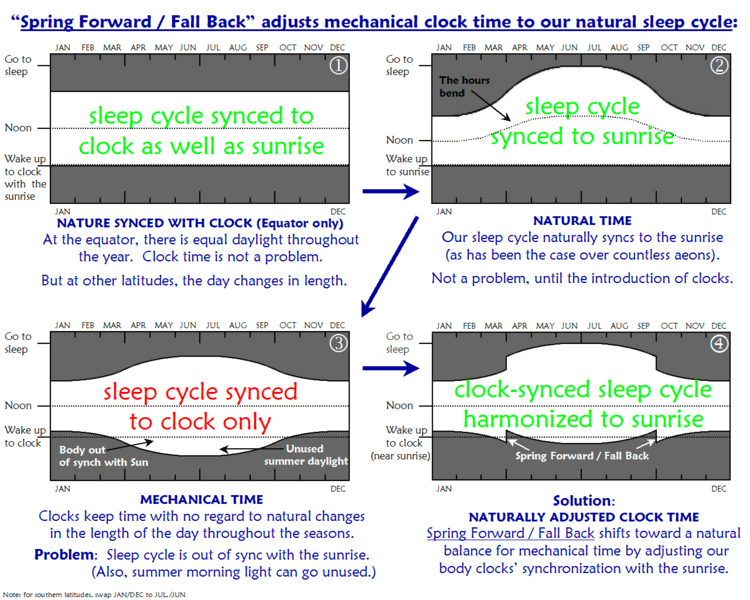Image: SpringFwd-FallBack

Description: The biological basis for “Spring-Forward/Fall-Back”: The “Spring-Forward/Fall-Back” adjustment is explained as a correction of rigid mechanical time toward flexible natural time so that clock time shifts toward the natural synchronization of our body clocks to the sunrise as it changes throughout the seasons. The natural cycle shown in Chart #2 is more closely matched by Chart #4 (with the Spring-Forward/Fall-Back shift) rather than the unshifted Chart #3. This shows that the biggest justification for shifting our clocks twice each year is that it is a "naturally adjusted clock time". All arguments about whether or not money is saved is secondary to this primary understanding that if we had no clocks, we would naturally wake up throughout the year in synch with the sunrise. "Daylight Savings Time" serves to be a "Naturally Adjusted Clock Time". As Chart #1 shows, there is no need for such a shift for those living near the equator, because the length of daytime at low latitudes does not vary as much as it does at higher latitudes. This world map clearly shows how the vast majority of the global population lives significantly north of the equator, and therefore realizes this benefit from the practice of shifting their clocks: World population density 1994 - with equator.png Natural time is called flexible (where "the hours bend") because hours historically were divisions of time from sunrise to sunset. Sunrise to noon was divided equally, as was noon to sunset. Also sunset to midnight and midnight to sunrise. So Summer had longer daytime hours and short nighttime hours. Winter had shorter day-hours with longer night-hours.
Title: SpringFwd-FallBack
Credit: Own work
Author: Invent2HelpAll
Usage Terms: Creative Commons Attribution-Share Alike 4.0
License: CC BY-SA 4.0
License Link: http://creativecommons.org/licenses/by-sa/4.0
Attribution Required?: Yes
Image usage
There are no pages that link to this image.

